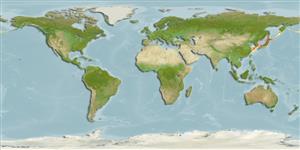Common names from other countries
Environment: milieu / climate zone / depth range / distribution range
Ecologie
; diepteverspreiding 0 - 80 m (Ref. 289). Subtropical
Northwest Pacific: Korea, Japan, and China.
Length at first maturity / Size / Gewicht / Leeftijd
Maturity: Lm ? range ? - ? cm Max length : 2.5 cm TL mannelijk/geslacht niet bekend; (Ref. 283)
Body elongate, oval shaped; moderately elevated. Valve slate-blue, dark olive-grey or dark grayish brown with blotches of creamy white. Central areas minutely pitted in a chevron-like or quincuncial pattern. Lateral areas slightly raised, clearly marked; sculptured with flat, radiating costae. Girdle narrow; colored like the valves, sometimes with alternating bands of lighter and darker tones; covered with imbricating scales.
Occurs in stony bottoms and in oyster beds (Ref. 289); undersurfaces of stones and rocks (Ref. 1867). Found from intertidal to 80 m (Ref. 75835).
Life cycle and mating behavior
Geslachtsrijpheid | Voortplanting | Kuitschieten | Eieren | Fecundity | Larven
Members of the class Polyplacophora are mostly gonochoric. Life cycle: Eggs hatch into lecitotrophic planktonic trocophore larvae (no veliger stage) which later metamorphose and settle on the bottom as young adults.
Burghardt, G. and L. Burghardt. 2006. (Ref. 283)
Status op de Rode Lijst van het IUCN (Ref. 130435)
Status bij CITES (Ref. 108899)
Not Evaluated
Not Evaluated
Gevaarlijk voor mensen
Harmless
Gebruik door de mens
| FishSource |
Tools
Meer informatie
Leeftijd/GrootteGroeiLengte-gewicht parametersLengte-lengte parametersMorfologieLarvenAbundantie
Internet-bronnen
Estimates based on models
Preferred temperature
(Ref.
115969): 10.2 - 23.9, mean 17.1 (based on 60 cells).
Kwetsbaarheid
Low vulnerability (10 of 100).
Prijsklasse
Unknown.
